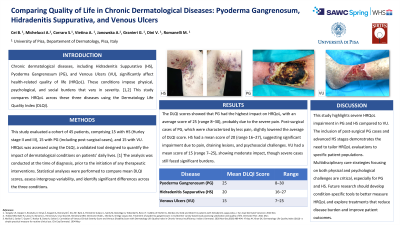Case Series/Study
(CS-026) Comparing Quality of Life in Chronic Dermatological Diseases: Pyoderma Gangrenosum, Hidradenitis Suppurativa, and Venous Ulcers
Friday, May 2, 2025
7:45 PM - 8:45 PM East Coast USA Time

Alessandra Michelucci, MD; Giammarco Granieri, MD; Valentina Dini, PhD; Marco Romanelli, PhD
Introduction: Chronic dermatological diseases, including Hidradenitis Suppurativa (HS), Pyoderma Gangrenosum (PG), and Venous Ulcers (VU), significantly affect health-related quality of life (HRQoL). These conditions impose physical, psychological, and social burdens that vary in severity. This study compares HRQoL across these three diseases using the Dermatology Life Quality Index (DLQI).
Methods: This study evaluated a cohort of 45 patients, comprising 15 with HS (Hurley stage II and III), 15 with PG (including post-surgical cases), and 15 with VU. HRQoL was assessed using the DLQI, a validated tool designed to quantify the impact of dermatological conditions on patients' daily lives. The analysis was conducted at the time of diagnosis, prior to the initiation of any therapeutic interventions. Statistical analyses were performed to compare mean DLQI scores, assess intergroup variability, and identify significant differences across the three conditions.
Results: The DLQI scores showed that PG had the highest impact on HRQoL, with an average score of 25 (range 8–30). This reflects the chronic and recurrent nature of the disease, although post-surgical cases, which had less pain, slightly lowered the average. HS had a mean score of 20 (range 16–27), indicating significant impairment due to pain, draining lesions, and psychosocial challenges. VU had a mean score of 15 (range 7–25), showing moderate impact, though severe cases still faced significant burdens.
Discussion: This study highlights severe HRQoL impairment in PG and HS compared to VU. The inclusion of post-surgical PG cases and advanced HS stages demonstrates the need to tailor HRQoL evaluations to specific patient populations. Multidisciplinary care strategies focusing on both physical and psychological challenges are critical, especially for PG and HS. Future research should develop condition-specific tools to better measure HRQoL and explore treatments that reduce disease burden and improve patient outcomes.
Methods: This study evaluated a cohort of 45 patients, comprising 15 with HS (Hurley stage II and III), 15 with PG (including post-surgical cases), and 15 with VU. HRQoL was assessed using the DLQI, a validated tool designed to quantify the impact of dermatological conditions on patients' daily lives. The analysis was conducted at the time of diagnosis, prior to the initiation of any therapeutic interventions. Statistical analyses were performed to compare mean DLQI scores, assess intergroup variability, and identify significant differences across the three conditions.
Results: The DLQI scores showed that PG had the highest impact on HRQoL, with an average score of 25 (range 8–30). This reflects the chronic and recurrent nature of the disease, although post-surgical cases, which had less pain, slightly lowered the average. HS had a mean score of 20 (range 16–27), indicating significant impairment due to pain, draining lesions, and psychosocial challenges. VU had a mean score of 15 (range 7–25), showing moderate impact, though severe cases still faced significant burdens.
Discussion: This study highlights severe HRQoL impairment in PG and HS compared to VU. The inclusion of post-surgical PG cases and advanced HS stages demonstrates the need to tailor HRQoL evaluations to specific patient populations. Multidisciplinary care strategies focusing on both physical and psychological challenges are critical, especially for PG and HS. Future research should develop condition-specific tools to better measure HRQoL and explore treatments that reduce disease burden and improve patient outcomes.

.jpg)